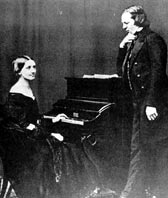Inside the Fortepiano
by Leslie Crane

|
||
|
On Saint Paul Sunday this week, fortepianist Cyril Huvé plays the music of Schumann and Liszt on a piano much like one used at the time the pieces were composed. As Huvé notes in the program, the original musical manuscript of Liszt's Album d’un Voyageur contained many notes that were eventually erased - the fortepiano, the early instrument for which the piece was composed, required more musical "activity" to keep its sound continuous. As the piano changed through time, the richness in tone and ability to sustain increased, changing a composer's approach to writing music for the instrument. Read on for a quick look at the life of this most versatile keyboard instrument.
The "piano" that we know today evolved from the need for keyboardists to have more control over the volume of their playing. Striking the keys of a harpsichord caused the strings inside to be plucked, producing the same volume for each note played. But a new instrument shaped like a harpsichord was built, and inside this one were hammer mechanisms on a fixed rail above the strings. These hammers stuck the strings, rather than plucking them, allowing players to influence the sound, producing loud ("forte") or soft ("piano") tones.
This new instrument, the "fortepiano," was gradually adapted to the music of the time with heavier hammers and strings and stronger frames to support them. Famous fortepiano makers like Johann Andreas Stein, Anton Walter, and Conrad Graf became the best builders of the "Viennese action" fortepianos. Inside these new versions of the instrument were hammers that pivoted on forks at the backs of the keys, rather than on the fixed rail. This action resulted in the ability to play faster musical passages and repeated notes. (Franz Liszt broke so many strings on his Graf piano that the need continued for stronger and louder pianos that would hold up under his rigorous playing!)

|
||
|
Pedals or knee levers were also added to produce other effects. Our modern pianos still have the damper and soft pedals, but some of these early models had additional pedals that created "Turkish percussion" and other unusual effects. Fortepiano keyboards were usually shorter than our standard 88-key pianos today; most were only 5 or 6 octaves (66 to 80 keys). The keys themselves on the early fortepiano, compared to our modern piano, were shorter as well as slightly narrower so that large intervals were easily reached.
The modern grand piano we know today is the result of the gradual "fine tuning" of its ancestors. Innovations in stringing methods, structure, and action, as well as materials such as wire and wood have increased its richness of tone and the range of its possible musical colors. As an artist currently devoted to the piano in several stages of its historical development, Cyril Huvé demonstrates the ranges of both the Graf fortepiano and the modern grand piano - an intriguing and often surprising contrast.








